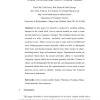Free Online Productivity Tools
i2Speak
i2Symbol
i2OCR
iTex2Img
iWeb2Print
iWeb2Shot
i2Type
iPdf2Split
iPdf2Merge
i2Bopomofo
i2Arabic
i2Style
i2Image
i2PDF
iLatex2Rtf
Sci2ools
116
Voted
IJON
2002
2002
The recognition and analysis of animate objects using neural networks and active contour models
: In this paper we describe a method for tracking walking humans in the visual field. Active contour models are used to track moving objects in a sequence of images. The resulting contours are then encoded in a scale-, location-, resolution- and control point rotationinvariant vector. These vectors are used to train and test feedforward error-backpropagation neural networks, which are able to distinguish both static and dynamic human objects from other classes of object, including horses, dogs and inanimate objects. Experimental results are presented which show the neural network's ability to successfully categorise objects which have become partially occluded. Classes of object can be distinguished by the network, and experimental results are presented which show how the representational vectors used as input patterns can be used to identify, classify and analyse the temporal behaviour of pedestrians.
Related Content
| Added | 22 Dec 2010 |
| Updated | 22 Dec 2010 |
| Type | Journal |
| Year | 2002 |
| Where | IJON |
| Authors | Ken Tabb, Neil Davey, Rod Adams, Stella J. George |
Comments (0)

